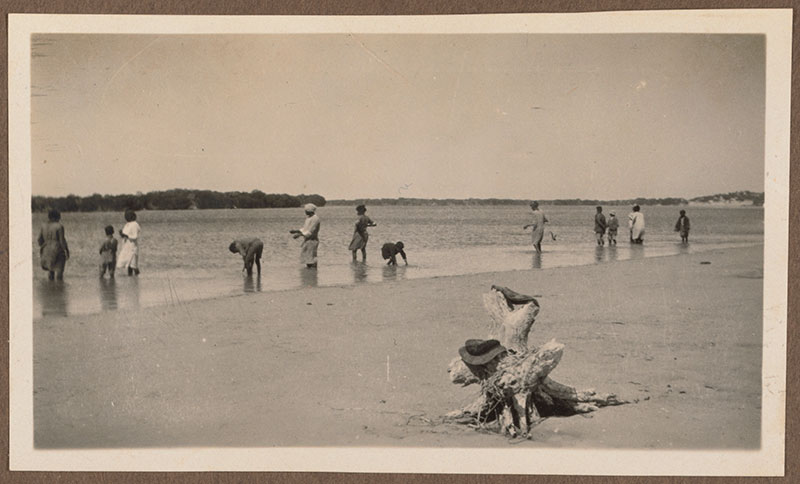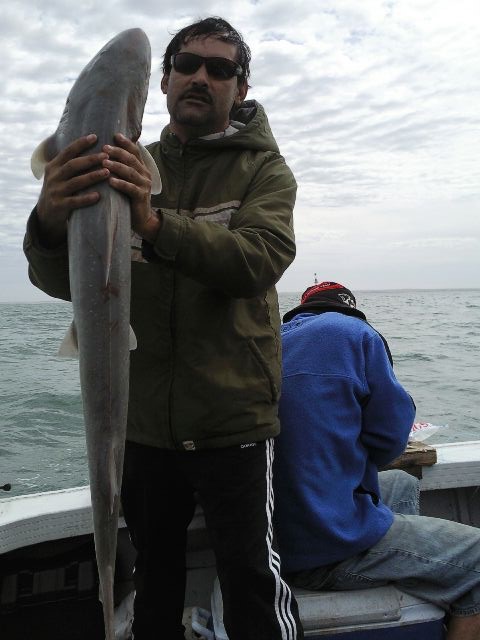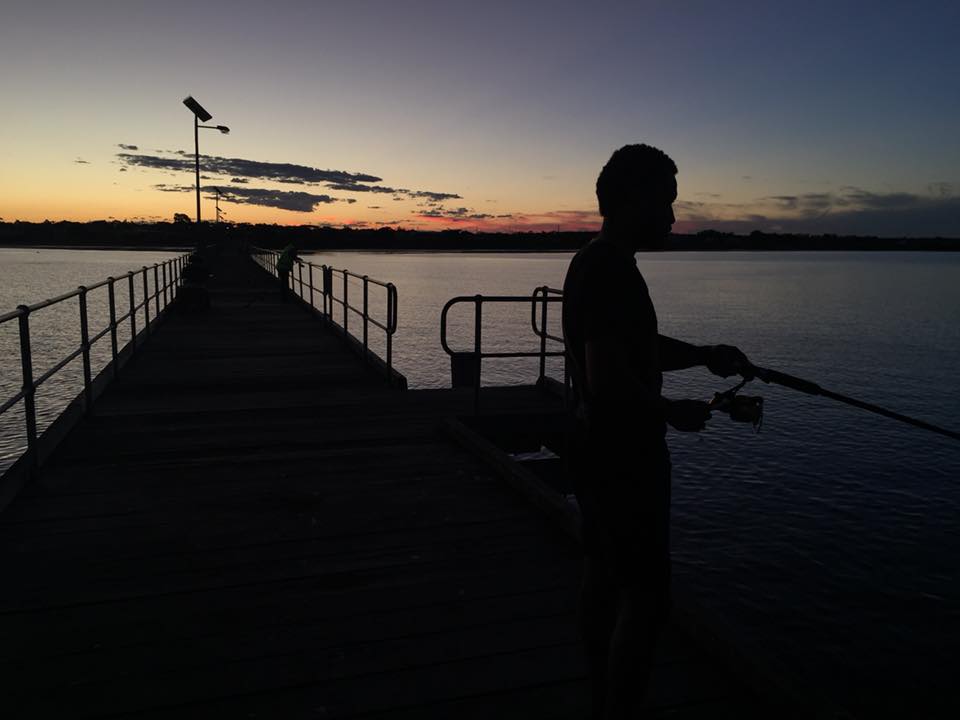The Far West Coast of South Australia has been home to a number of Aboriginal peoples for at least 40,000 years. While the land is arid and semi-arid and dominated by the Nullarbor Plain, the waters of the Great Australian Bight provide an incredible bounty.
Sandy beaches and rocky platforms alternate in the sheltered bays in the east near the town of Ceduna, giving way to the towering Bunda Cliffs from the Head of the Bight to the border with Western Australia.
The Aboriginal peoples of the Far West Coast made a living from the sea from the earliest times; some of the first archaeological evidence of their presence is a fish vertebra found in the limestone caves of the Nullarbor.
Middens found all along the coast show people ate a wide variety of shellfish, including periwinkles, abalone and turban shells. They also took advantage of naturally occurring fish traps like rock pools and shallow ponds in estuaries, as well as making their own from rocks and wood. People also exploited the resources of the islands of the Nuyts Archipelago south of Ceduna.
During the mission times a much loved Sunday outing was a trip by horse and buggy from Koonibba Mission to Davenport Creek to swim and enjoy wanna ma (coastal food). Today the Aboriginal peoples of the Far West Coast still cherish their wanna ma: favourites include razor fish (a type of clam), galda maru (blue swimmer crabs), moona ma (limpets), mussels, oysters and abalone. Mudi (fish) that people catch from the beaches and jetties include mulloway, salmon, flathead and sometimes even tuna.
In addition to being a source of sustenance, the sea is an important part of their cultures. The Mirning people of the west are ‘people of the whale’, and have songs they sing to southern right whales. The sea lion and sea eagle are likewise important totems for the Wirangu people, and the saltwater families of the Gugada people have a number of beaches and fishing spots which are sacred to them.
The fisheries of the Far West Coast sea country are among the most productive and unspoilt in the country. Ceduna hosts a thriving commercial industry that targets King George whiting and bluefin tuna, among others, as well as a number of oyster farms for which the town is famous.
There are a small number of Aboriginal professional fishers, and until recently one of the oyster farms was jointly owned by an Aboriginal corporation and provided employment and training for young Aboriginal people.
The Far West Coast Aboriginal Corporation has looked after country on behalf of the Far West Coast traditional owners since their native title was recognised in 2013. The Far West Coast native title claim combined the claims of the six different cultural groups of the region: the Mirning people, the Wirangu people, the Kokatha people, the Yalata people, the Maralinga Tjarutja people, and the descendants of Edward Roberts.
In 2016 the traditional owners also filed a claim to have their native title over the seas of the Far West Coast recognised which people hope will give them more options to use fishing to achieve community aspirations.

Aboriginal youth and children from Koonibba Children’s Home fishing at Davenport Creek, 1920-1930, Davenport Creek, SA. Courtesy of the National Library of Australia, nla.obj-152903856.
Aboriginal youth and children from Koonibba Children’s Home fishing at Davenport Creek, 1920-1930, Davenport Creek, SA. Courtesy of the National Library of Australia, nla.obj-152903856.
Values
Sharing is at the heart of marine resource use for Aboriginal people on the Far West Coast. Whether someone is fishing off a boat, beach or jetty, or collecting shellfish or crabbing, they always make sure they get enough to feed the family. Elders always get the first preference once your immediate family is fed, as well as people who might not be able to go themselves.
Fishing and collecting shellfish are unavoidably social activities, and not just because the catch is shared. Going out to get a feed often means bringing along the whole family, and so fishing helps keep families close and strong. Family fishing and collecting outings are also how kids learn; they watch how their parents, grandparents, uncles, aunties, and older cousins and siblings do things.
Essential knowledge about what can and can’t be eaten, how, where and when to get different species and how to stay safe is also passed on, as well as the stories of the culturally significant places that are visited.
Children also need to learn the rules about fishing sustainably. For there to be enough wanna ma for the future, it has to be looked after and treated with respect, and there are rules that Far West Coast Aboriginal people follow and pass on to ensure this.
The first is to never take more than you need; everything that is caught or collected needs to be eaten, or put back. Another is that even if you need to feed a lot of people, don’t take too much of one thing from the same place. This is so the population has a chance to replenish. Female galda maru (crabs) are never taken, whether or not they have eggs, for the same reason.
Seafood and fishing are central to the cultural and social fabric of the Far West Coast and this doesn’t change when someone leaves the region. Far West Coast Aboriginal people still feel connected to their country and crave their wanna ma.
Many families have members who have moved to places like Adelaide to find work. For them to be able to fish, collect and eat together when they come back to visit is important for family bonding, keeping culture strong and maintaining their connection to country.
Fishing is also a huge benefit to many people because it allows them to provide their family with a healthy diet on a budget. High unemployment and low incomes are problems on the Far West Coast like in many regional and remote areas, and especially for Aboriginal people.
Lots of foods, like fresh fruit and vegetables, tend to be more expensive than in other places. When it comes to seafood, many people simply can’t afford to buy it regularly, even the local stuff. The ability to easily go and get fresh, healthy seafood for dinner at little cost is invaluable for many families. And, because of the cultural obligation to share, this effect ripples out across much of the community.
Barriers and Effects
Issues around access are among the most often mentioned by Aboriginal people on the Far West Coast. While the fisheries in the region are some of the most productive in the country, this means they are also some of the most popular. Ceduna and other hotspots like Yalata see thousands of recreational fishers every year, and local Aboriginal people express fears that while many visitors do the right thing, some don’t.
Most people note that it is harder to catch many species than in the past; they mostly put this down to there being fewer fish because there are more fishers. Both Aboriginal and non-Aboriginal people have stories of visitors catching and freezing fish to sell to finance their holidays. In some places entire beaches have been ‘cleaned out’ of razor fish in a matter of days, leaving few or none to let the population grow back.
While fishing and collecting rights should be guaranteed for native title holders under s 211 of the Native Title Act, this doesn’t guarantee access to fishing spots. Some Aboriginal people complained that culturally significant fishing and collecting spots are almost impossible to reach, as the land that people need to cross to access them is privately owned. Whether they can get to a certain spot is often dependent on the goodwill of the land owner.
While they might need to take well over the individual daily limit for some species in order to feed their whole family, usually people make sure there are enough people coming on a fishing or collecting outing so that the limit per person is not exceeded.
Even so, some Far West Coast Aboriginal people believe they are unfairly targeted by Fisheries SA officers, making them feel like they are being stereotyped and are assumed to be criminals despite the fact they follow the rules and have a native title right to fish. Sometimes they are put off from fishing or collecting because of this, and so the children aren’t taught.
When it comes to involvement in commercial fishing and aquaculture, many people mentioned how difficult it is for Far West Coast Aboriginal people to get a licence to begin with. Applying for licences is often a complicated and difficult process, on top of the sometimes tens of thousands of dollars needed to buy one.
Another issue is that the pool of licences is limited; bringing more Far West Coast Aboriginal people into the industry as it stands usually requires an existing fisher who is willing to sell their licence. One Gugada man told us that when he tried to start out as a commercial abalone diver he planned the business and arranged financing to pay the $90,000 for a licence, but in the end no one would sell one to him so he had to give up.
Aspirations
Having their native title over the sea recognised is a fundamental aspiration for many people. Besides the importance of the recognition itself, it is hoped that it will open up new pathways for creating livelihoods and managing their sea country and wanna ma.
At the moment there is an Indigenous Ranger program that works within the Yalata Indigenous Protected Area in the west of the region. The success of these rangers, who manage their traditional lands, protect their sacred sites and control access to the lands through permits, has spurred interest in setting up ranger programs for the whole region.
Taking on more management of their seas and wanna ma is a particular focus for Far West Coast Aboriginal people, given how important fishing is culturally, socially and economically to the region. As such, the Far West Coast Aboriginal Corporation setting up a sea ranger program is a popular option. An Aboriginal sea ranger program would provide jobs and allow traditional owners to play a greater role in the protection of their seas and fisheries.
One suggestion is that the Aboriginal sea rangers should have fisheries enforcement powers. Fisheries enforcement that is culturally appropriate and aware of the local ways of fishing and collecting would be appreciated by the community.
This is especially important going forward, to ensure the fishing rights and interests that accompany the sea claim are recognised and respected. Some people also think that this would make it easier to deal with any traditional owners or Aboriginal visitors from other regions who might be breaking the rules.
Greater opportunities to engage in commercial fishing and aquaculture are also high on the list. Fishing is an important industry in Ceduna, and careers in fishing and aquaculture would allow people to earn a living while being on sea country and using skills and knowledge that many pick up from an early age.
‘I think there probably needs to be a bit more of that sort of stuff, and probably Aboriginal-run, upskill local Aboriginal people to be able to run and manage it, and be able to do traineeships with younger ones. I think that’s really important, for our young people to have opportunities and to be trained and taught properly.’
Securing formal assistance for Far West Coast Aboriginal people to buy commercial licences and fisheries shares and get the required certifications has been identified as an important first step. It is hoped that creating these career paths that allow young people to stay with their families and on their country, rather than moving to Adelaide and other centres to find work, will help keep families, country and culture strong.


